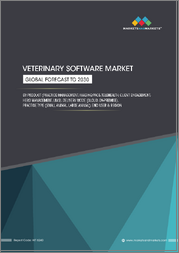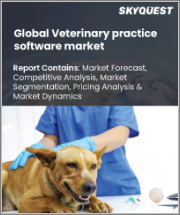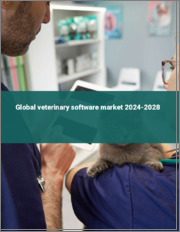
|
시장보고서
상품코드
1819969
수의용 소프트웨어 시장 보고서 : 제품, 딜리버리 모드, 진료 유형, 최종 사용, 지역별(2025-2033년)Veterinary Software Market Report by Product, Delivery Mode, Practice Type, End Use, and Region 2025-2033 |
||||||
세계 수의용 소프트웨어 시장 규모는 2024년 5억 8,440만 달러에 달했습니다. IMARC Group은 2033년까지 9억 6,160만 달러에 달하고, 2025-2033년 5.4%의 연평균 성장률(CAGR)을 보일 것으로 전망하고 있습니다.
수의용 소프트웨어는 수의사가 일상 업무를 효율화하고 회계 등 백오피스 기능을 완료하기 위해 활용되고 있습니다. 환자 정보 관리, 치료 계획 및 스케줄링, 커뮤니케이션 및 고객 관계 개선을 지원합니다. 또한 프로세스를 간소화하고, 수의사 팀의 효율성을 높이고, 데이터를 수집하고, 보고서를 작성하고, 종이 사용을 줄임으로써 지속 가능한 관행을 따르도록 돕습니다. 현재 고급 수의 진료 관리 소프트웨어는 동물병원에서 사용되고 있으며, 소규모 진료소에서는 축소된 버전이 사용되고 있습니다.
수의용 소프트웨어 시장 동향 :
반려동물 사육 증가, 인수공통전염병의 유행, 동물 건강검진에 대한 수요 증가는 시장 성장을 강화하는 주요 요인 중 하나입니다. 수의용 소프트웨어는 약품 데이터베이스를 유지하고, 생산성을 향상시키며, 시간을 절약할 수 있습니다. 그 결과, 동물병원과 동물병원의 일상 업무를 감독할 필요성이 크게 증가하여 시장 성장을 뒷받침하고 있습니다. 또한, 클라우드 기반 진료 관리 시스템 등 기술적으로 진보된 소프트웨어의 채택이 증가하고 있으며, 모든 프로세스에 대해 하나의 플랫폼에서 솔루션을 제공하는 것이 시장 성장을 가속하고 있습니다. 이 고급 소프트웨어는 사업 수익성 모니터링, 진단 이미지 저장, 환자 데이터 통합 및 실적 추적, 약품 재고 주문, 모바일 단말기를 통한 데이터 액세스를 지원합니다. 반려동물 건강관리를 위한 비용 효율적인 소프트웨어 솔루션으로, 이중 진료, 상담, 교육 등 다양한 목적으로 다른 수의사들과 원격으로 공유할 수 있습니다. 이는 동물에게 더 나은 보살핌을 제공하고 시장 성장을 가속하고 있습니다. 기타 요인으로는 반려동물 보험의 가용성 증가, 반려동물 수 증가, 동물 의료비 지출 증가, 동물성 식품에 대한 수요 증가, 수의사 수의사 급증 등이 시장 전망을 밝게 하는 요인으로 작용할 것으로 예측됩니다.
본 보고서에서 다룬 주요 질문
- 세계 수의용 소프트웨어 시장 규모는?
- 2025-2033년 세계 수의용 소프트웨어 시장의 예상 성장률은?
- 세계 수의용 소프트웨어 시장을 이끄는 주요 요인은?
- 코로나19가 세계 수의용 소프트웨어 시장에 미치는 영향은?
- 세계 수의용 소프트웨어 시장에서의 제품별 분류는?
- 세계 수의용 소프트웨어 시장에서의 전달 방식별 분류는?
- 세계 수의용 소프트웨어 시장의 진료 유형별 분류는?
- 세계 수의용 소프트웨어 시장의 최종 용도별 분류는?
- 세계 수의용 소프트웨어 시장의 주요 지역은?
- 세계 수의용 소프트웨어 시장의 주요 업체는?
목차
제1장 서문
제2장 조사 범위와 조사 방법
- 조사 목적
- 이해관계자
- 데이터 소스
- 1차 정보
- 2차 정보
- 시장 추정
- 보텀업 접근
- 톱다운 접근
- 조사 방법
제3장 주요 요약
제4장 서론
제5장 세계의 수의용 소프트웨어 시장
- 시장 개요
- 시장 실적
- COVID-19의 영향
- 시장 예측
제6장 시장 분석 : 제품별
- 진료 관리 소프트웨어
- 이미징 소프트웨어
- 기타
제7장 시장 분석 : 딜리버리 모드별
- On-Premise
- 클라우드 및 웹 기반
제8장 시장 분석 : 진료 유형별
- 작은 동물
- 혼합 동물
- 말
- 식용 동물
- 기타
제9장 시장 분석 : 최종 용도별
- 병원 및 진료소
- 참조 실험실
제10장 시장 분석 : 지역별
- 북미
- 미국
- 캐나다
- 아시아태평양
- 중국
- 일본
- 인도
- 한국
- 호주
- 인도네시아
- 기타
- 유럽
- 독일
- 프랑스
- 영국
- 이탈리아
- 스페인
- 러시아
- 기타
- 라틴아메리카
- 브라질
- 멕시코
- 기타
- 중동 및 아프리카
제11장 SWOT 분석
제12장 밸류체인 분석
제13장 Porter의 Five Forces 분석
제14장 가격 분석
제15장 경쟁 구도
- 시장 구조
- 주요 기업
- 주요 기업 개요
- Animal Intelligence Software Inc.
- ClienTrax
- Covetrus Inc.
- Esaote SpA
- Henry Schein Inc.
- Hippo Manager Software Inc.
- IDEXX Laboratories Inc.
- Onward Computer Systems
- Patterson Companies Inc.
- Timeless Veterinary Systems Inc.
- Vetter Software Inc.(DaySmart Software Inc.)
- VIA Information Systems
The global veterinary software market size reached USD 584.4 Million in 2024. Looking forward, IMARC Group expects the market to reach USD 961.6 Million by 2033, exhibiting a growth rate (CAGR) of 5.4% during 2025-2033.
Veterinary software is utilized by veterinarians for streamlining everyday operations and completing back-office functions like accounting. It assists in managing patient information, planning and scheduling treatments and improving communication and client relationships. It also aids in simplifying the process and increasing the efficiency of the veterinary team, collecting data and creating reports, and following sustainable practices by reducing the use of paper. At present, advanced veterinary practice management software finds application in veterinary hospitals, while scaled-down versions are employed in small clinics.
Veterinary Software Market Trends:
The increasing adoption of pets, rising prevalence of zoonotic diseases, and the escalating demand for animal health diagnostics are among the key factors strengthening the growth of the market. Veterinary software maintains drug databases, improves productivity and saves time. Consequently, a significant rise in the need for supervising daily tasks in animal clinics and hospitals is supporting the market growth. Furthermore, the growing adoption of technologically advanced software, such as cloud-based practice management systems, which provide solutions in one platform for all processes is impelling the market growth. This advanced software assists in monitoring business profitability, storing diagnostic images, integrating patient data and tracking performance, ordering drug inventory, and accessing data from a portable device. It is a cost-efficient software solution for pet health practices, which can be remotely shared with other veterinary practitioners for various purposes like dual treatments, consultations, and training. It is providing better care to animals, which, in turn, is propelling the market growth. Some of the other factors, including increasing availability of pet insurance, rising pet population, growing animal healthcare expenditure, escalating demand for animal-derived food products and the surging number of veterinary practitioners, are anticipated to create a favorable outlook for the market.
Key Market Segmentation:
Breakup by Product:
- Practice Management Software
- Imaging Software
- Others
Breakup by Delivery Mode:
- On-premises
- Cloud/Web-Based
Breakup by Practice Type:
- Small Animals
- Mixed Animals
- Equine
- Food-producing Animals
- Others
Breakup by End Use:
- Hospitals and Clinics
- Reference Laboratories
Breakup by Region:
- North America
- United States
- Canada
- Asia-Pacific
- China
- Japan
- India
- South Korea
- Australia
- Indonesia
- Others
- Europe
- Germany
- France
- United Kingdom
- Italy
- Spain
- Russia
- Others
- Latin America
- Brazil
- Mexico
- Others
- Middle East and Africa
Competitive Landscape:
The competitive landscape of the industry has also been examined along with the profiles of the key players being Animal Intelligence Software Inc., ClienTrax, Covetrus Inc., Esaote SpA, Henry Schein Inc., Hippo Manager Software Inc., IDEXX Laboratories Inc., Onward Computer Systems, Patterson Companies Inc., Timeless Veterinary Systems Inc., Vetter Software Inc. (DaySmart Software Inc.) and VIA Information Systems.
Key Questions Answered in This Report
- 1.How big is the global veterinary software market?
- 2.What is the expected growth rate of the global veterinary software market during 2025-2033?
- 3.What are the key factors driving the global veterinary software market?
- 4.What has been the impact of COVID-19 on the global veterinary software market?
- 5.What is the breakup of the global veterinary software market based on the product?
- 6.What is the breakup of the global veterinary software market based on the delivery mode?
- 7.What is the breakup of the global veterinary software market based on the practice type?
- 8.What is the breakup of the global veterinary software market based on the end use?
- 9.What are the key regions in the global veterinary software market?
- 10.Who are the key players/companies in the global veterinary software market?
Table of Contents
1 Preface
2 Scope and Methodology
- 2.1 Objectives of the Study
- 2.2 Stakeholders
- 2.3 Data Sources
- 2.3.1 Primary Sources
- 2.3.2 Secondary Sources
- 2.4 Market Estimation
- 2.4.1 Bottom-Up Approach
- 2.4.2 Top-Down Approach
- 2.5 Forecasting Methodology
3 Executive Summary
4 Introduction
- 4.1 Overview
- 4.2 Key Industry Trends
5 Global Veterinary Software Market
- 5.1 Market Overview
- 5.2 Market Performance
- 5.3 Impact of COVID-19
- 5.4 Market Forecast
6 Market Breakup by Product
- 6.1 Practice Management Software
- 6.1.1 Market Trends
- 6.1.2 Market Forecast
- 6.2 Imaging Software
- 6.2.1 Market Trends
- 6.2.2 Market Forecast
- 6.3 Others
- 6.3.1 Market Trends
- 6.3.2 Market Forecast
7 Market Breakup by Delivery Mode
- 7.1 On-premises
- 7.1.1 Market Trends
- 7.1.2 Market Forecast
- 7.2 Cloud/Web-Based
- 7.2.1 Market Trends
- 7.2.2 Market Forecast
8 Market Breakup by Practice Type
- 8.1 Small Animals
- 8.1.1 Market Trends
- 8.1.2 Market Forecast
- 8.2 Mixed Animals
- 8.2.1 Market Trends
- 8.2.2 Market Forecast
- 8.3 Equine
- 8.3.1 Market Trends
- 8.3.2 Market Forecast
- 8.4 Food-producing Animals
- 8.4.1 Market Trends
- 8.4.2 Market Forecast
- 8.5 Others
- 8.5.1 Market Trends
- 8.5.2 Market Forecast
9 Market Breakup by End Use
- 9.1 Hospitals and Clinics
- 9.1.1 Market Trends
- 9.1.2 Market Forecast
- 9.2 Reference Laboratories
- 9.2.1 Market Trends
- 9.2.2 Market Forecast
10 Market Breakup by Region
- 10.1 North America
- 10.1.1 United States
- 10.1.1.1 Market Trends
- 10.1.1.2 Market Forecast
- 10.1.2 Canada
- 10.1.2.1 Market Trends
- 10.1.2.2 Market Forecast
- 10.1.1 United States
- 10.2 Asia-Pacific
- 10.2.1 China
- 10.2.1.1 Market Trends
- 10.2.1.2 Market Forecast
- 10.2.2 Japan
- 10.2.2.1 Market Trends
- 10.2.2.2 Market Forecast
- 10.2.3 India
- 10.2.3.1 Market Trends
- 10.2.3.2 Market Forecast
- 10.2.4 South Korea
- 10.2.4.1 Market Trends
- 10.2.4.2 Market Forecast
- 10.2.5 Australia
- 10.2.5.1 Market Trends
- 10.2.5.2 Market Forecast
- 10.2.6 Indonesia
- 10.2.6.1 Market Trends
- 10.2.6.2 Market Forecast
- 10.2.7 Others
- 10.2.7.1 Market Trends
- 10.2.7.2 Market Forecast
- 10.2.1 China
- 10.3 Europe
- 10.3.1 Germany
- 10.3.1.1 Market Trends
- 10.3.1.2 Market Forecast
- 10.3.2 France
- 10.3.2.1 Market Trends
- 10.3.2.2 Market Forecast
- 10.3.3 United Kingdom
- 10.3.3.1 Market Trends
- 10.3.3.2 Market Forecast
- 10.3.4 Italy
- 10.3.4.1 Market Trends
- 10.3.4.2 Market Forecast
- 10.3.5 Spain
- 10.3.5.1 Market Trends
- 10.3.5.2 Market Forecast
- 10.3.6 Russia
- 10.3.6.1 Market Trends
- 10.3.6.2 Market Forecast
- 10.3.7 Others
- 10.3.7.1 Market Trends
- 10.3.7.2 Market Forecast
- 10.3.1 Germany
- 10.4 Latin America
- 10.4.1 Brazil
- 10.4.1.1 Market Trends
- 10.4.1.2 Market Forecast
- 10.4.2 Mexico
- 10.4.2.1 Market Trends
- 10.4.2.2 Market Forecast
- 10.4.3 Others
- 10.4.3.1 Market Trends
- 10.4.3.2 Market Forecast
- 10.4.1 Brazil
- 10.5 Middle East and Africa
- 10.5.1 Market Trends
- 10.5.2 Market Breakup by Country
- 10.5.3 Market Forecast
11 SWOT Analysis
- 11.1 Overview
- 11.2 Strengths
- 11.3 Weaknesses
- 11.4 Opportunities
- 11.5 Threats
12 Value Chain Analysis
13 Porters Five Forces Analysis
- 13.1 Overview
- 13.2 Bargaining Power of Buyers
- 13.3 Bargaining Power of Suppliers
- 13.4 Degree of Competition
- 13.5 Threat of New Entrants
- 13.6 Threat of Substitutes
14 Price Analysis
15 Competitive Landscape
- 15.1 Market Structure
- 15.2 Key Players
- 15.3 Profiles of Key Players
- 15.3.1 Animal Intelligence Software Inc.
- 15.3.1.1 Company Overview
- 15.3.1.2 Product Portfolio
- 15.3.2 ClienTrax
- 15.3.2.1 Company Overview
- 15.3.2.2 Product Portfolio
- 15.3.3 Covetrus Inc.
- 15.3.3.1 Company Overview
- 15.3.3.2 Product Portfolio
- 15.3.3.3 Financials
- 15.3.4 Esaote SpA
- 15.3.4.1 Company Overview
- 15.3.4.2 Product Portfolio
- 15.3.5 Henry Schein Inc.
- 15.3.5.1 Company Overview
- 15.3.5.2 Product Portfolio
- 15.3.5.3 Financials
- 15.3.5.4 SWOT Analysis
- 15.3.6 Hippo Manager Software Inc.
- 15.3.6.1 Company Overview
- 15.3.6.2 Product Portfolio
- 15.3.7 IDEXX Laboratories Inc.
- 15.3.7.1 Company Overview
- 15.3.7.2 Product Portfolio
- 15.3.7.3 Financials
- 15.3.7.4 SWOT Analysis
- 15.3.8 Onward Computer Systems
- 15.3.8.1 Company Overview
- 15.3.8.2 Product Portfolio
- 15.3.9 Patterson Companies Inc.
- 15.3.9.1 Company Overview
- 15.3.9.2 Product Portfolio
- 15.3.9.3 Financials
- 15.3.9.4 SWOT Analysis
- 15.3.10 Timeless Veterinary Systems Inc.
- 15.3.10.1 Company Overview
- 15.3.10.2 Product Portfolio
- 15.3.11 Vetter Software Inc. (DaySmart Software Inc.)
- 15.3.11.1 Company Overview
- 15.3.11.2 Product Portfolio
- 15.3.12 VIA Information Systems
- 15.3.12.1 Company Overview
- 15.3.12.2 Product Portfolio
- 15.3.1 Animal Intelligence Software Inc.


















